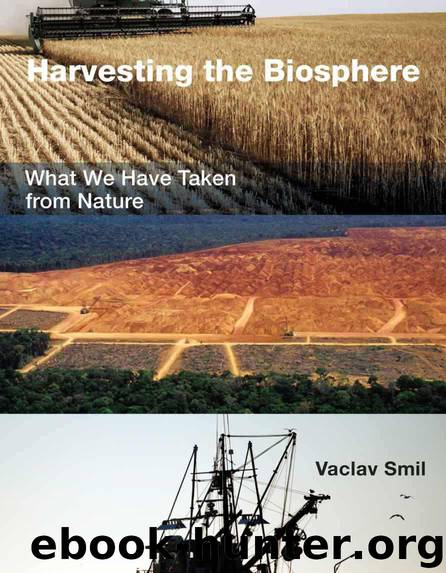Harvesting the Biosphere: What We Have Taken from Nature by Smil Vaclav

Author:Smil, Vaclav [Smil, Vaclav]
Language: eng
Format: mobi, azw3, epub
ISBN: 9780262312271
Publisher: The MIT Press
Published: 2012-12-20T16:00:00+00:00
Twenty Millennia of Phytomass Change
Given the lasting uncertainties in quantifying the aboveground phytomass in today’s ecosystems (leaving aside even greater errors in estimating the belowground biomass and its productivity), it may seem audacious to model global phytomass stores going back 20,000 years, to the last glacial maximum (LGM), or even “just” to about 10,000 years ago, to the preagricultural era of the early Holocene, or 5,000 years ago, to the mid-Holocene, the time of the first complex civilizations. The inherent uncertainties of such attempts are obvious, but the uncertain totals should be able to convey the magnitude of change between the LGM, when only small bands of dispersed hunters (totaling no more than few hundred thousand people) roamed the Earth, whose northern latitudes were covered by massive continental glaciers, and the era of maximum phytomass storage during the preagricultural period, when forests occupied large areas of Eurasia and North America.
Different studies have used global climate models and paleoecological, palynological, pedological, and sedimentological evidence to reconstruct past vegetation cover and carbon storage, usually expressing the latter as a combination of vegetation and soil carbon, with some studies including and others excluding the post-LGM peatland growth. Not surprisingly, there have been some extreme findings. After reconstructing past ecosystem distributions, Adams and Faure (1998) concluded that the total terrestrial carbon storage (plants, soils, and peat) 18,000 years before the present was only 931 Gt, compared to a total of 2,130 Gt C for the late twentieth century—the total arrived at by adding 560 Gt C in plants (Olson, Watts, and Allison 1983), 1,115 Gt C in nonpeat soils (Post et al. 1982), and 461 Gt C in peatlands (Gorham 1991)—a nearly 2.3-fold increase, for a net gain of about 1,200 Gt.
In contrast, Prentice and Fung (1990) claimed that (excluding peat) there was no significant increase in overall terrestrial carbon storage, putting the overall LGM-to-present carbon gain at 0 ± 50 Gt C: this would mean that the terrestrial biosphere was no (or not a major) carbon sink during the period of rapid deglaciation. But Prentice et al. (1993) presented a new model that showed the late twentieth-century terrestrial carbon storage to be at least 300 Gt C and as much as 700 Gt C higher than during the LGM. Moreover, seven other studies published by 1998 converged to a very similar range, indicating a gain of about 30% in the overall terrestrial carbon storage (in absolute terms, mostly 300–700 Gt C) from the time of the LGM to the late twentieth century (Peng, Guiot, and Van Campo 1998).
Two more studies came out in 1999, the first one echoing the just noted consensus and concluding that the total terrestrial carbon addition since the LGM amounted to 550–680 Gt (Beerling 1999), the other one ending up with LGM totals ranging from 710 Gt C less to 70 Gt C more than the present level (François et al. 1999). And two studies published in 2002 (for some reason, these reconstructions have not been pursued after that
Download
Harvesting the Biosphere: What We Have Taken from Nature by Smil Vaclav.azw3
Harvesting the Biosphere: What We Have Taken from Nature by Smil Vaclav.epub
This site does not store any files on its server. We only index and link to content provided by other sites. Please contact the content providers to delete copyright contents if any and email us, we'll remove relevant links or contents immediately.
| Acoustics | Bridges |
| Earthwork Design | Environmental |
| Fire Science | Highway & Traffic |
| Hydrology | Remote Sensing |
| Seismic Design | Structural |
| Structural Dynamics | Surveying & Photogrammetry |
| Transportation |
Whiskies Galore by Ian Buxton(41937)
Introduction to Aircraft Design (Cambridge Aerospace Series) by John P. Fielding(33092)
Small Unmanned Fixed-wing Aircraft Design by Andrew J. Keane Andras Sobester James P. Scanlan & András Sóbester & James P. Scanlan(32763)
Craft Beer for the Homebrewer by Michael Agnew(18196)
Turbulence by E. J. Noyes(7977)
The Complete Stick Figure Physics Tutorials by Allen Sarah(7336)
Kaplan MCAT General Chemistry Review by Kaplan(6899)
The Thirst by Nesbo Jo(6877)
Bad Blood by John Carreyrou(6581)
Modelling of Convective Heat and Mass Transfer in Rotating Flows by Igor V. Shevchuk(6406)
Learning SQL by Alan Beaulieu(6237)
Weapons of Math Destruction by Cathy O'Neil(6214)
Man-made Catastrophes and Risk Information Concealment by Dmitry Chernov & Didier Sornette(5956)
Digital Minimalism by Cal Newport;(5704)
Life 3.0: Being Human in the Age of Artificial Intelligence by Tegmark Max(5512)
iGen by Jean M. Twenge(5384)
Secrets of Antigravity Propulsion: Tesla, UFOs, and Classified Aerospace Technology by Ph.D. Paul A. Laviolette(5332)
Design of Trajectory Optimization Approach for Space Maneuver Vehicle Skip Entry Problems by Runqi Chai & Al Savvaris & Antonios Tsourdos & Senchun Chai(5037)
Pale Blue Dot by Carl Sagan(4953)
